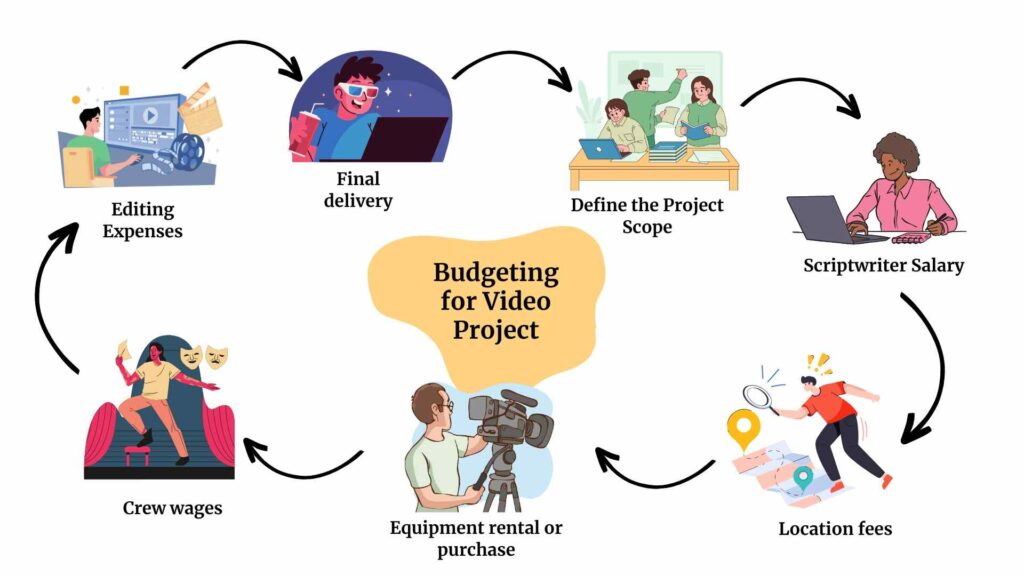When HubSpot pointed out how video marketing generates leads, 83% of video marketers said yes. From small business owners to well-established marketers, they didn’t delay incorporating videos in their marketing strategies.
But then again, what comes to pretty much everyone’s mind is:

They were thinking about the budget needed to produce a worthy video. Is it going to cost too much, or is it worth all the spending?
The answer is subjective. No, we aren’t giving you any vague answers.
When you are asking about the video production budget, the answer lies within two factors:
- The agency you are choosing to work with and their price rates.
- The kind of production you want for your projects.
Find the answers to the above questions. In the meantime, we will tell you how much video production will cost. Write it down so you don’t forget.
Typical Video production pricing (Agency/Company) | 3,000 to over 2,00,000 US dollars (Talking about hourly rates, they range from $100 to $149, but it varies a lot.) | ||
| Small Projects | Medium Projects | Large Projects | |
| Under 5,000$ | Approximately $5,000 – $15,000 | Mostly $15,000+ to above | |
Since we are here to provide a video production pricing guide, it is meant to be detailed. Read further to get an idea of how much video production will cost and how you can easily find all-in-one solutions with a professional video production company.
Understanding the Basics of Video Production Costs
The production house you choose for the video or the video you make for the project will be based on its length and complexity.
So, the pricing of the video production will be on its:
– How complex the project is
– The quality of the production
– The experience level of the production team
– The duration of the video
When you are ready to make the budget, you have to count all stages to find the actual cost of producing a video. Video production comes in three stages. The first step is getting ready (pre-production), the second one is creating magic (production), and the last step is finishing up (post-production). Therefore, you will decide what these will cost for the entire project.
Pre-Production
If you can nail down a solid pre-production plan, the overall cost will be way less than you think.

[Source: Sqds GIF – Sqds – Discover & Share GIFs]
- Planning and scripting: Here, you will write a script for the concept, create a storyboard, and figure out how long the video will be to convey the main message to the audience.
- Cost Distribution: Screenwriter fees, script editing, storyboarding. The budget includes extra revisions and research, which all add to the cost.
- Pre-production Meetings: Discussions between the production team, including the director, producer, and key crew members.
- Cost Distribution: The costs here will be meeting and travel expenses for team members.
- Location Scouting: Picking locations where the video will be shot. It can be indoor or outdoor and requires multiple location changes.
- Cost Distribution: Location scouting fees, travel expenses, and location permits. The cost of location scouting will depend on the location, size, and amenities. You might have to allocate more budget if transportation and lodging are added to it.
Production
The production stage mainly covers the costs during filming and the pricing for video production services.

[Source: Walking Backward Cameraman GIF]
- Filming: The actual shooting of the video, including camera operation, lighting, sound recording, and direction.
- Cost Distribution: Here, you will need to spend on director’s fees, camera operator fees, lighting technician fees, sound engineer fees, and production assistant fees.
- Casting: Finding and hiring the number of actors, voice-over artists, extras, or other talents that might be needed.
- Cost Distribution: Casting director fees, talent fees, audition expenses. You will have a better idea of the total budget once you determine the number of people you will need.
- Equipment Rental: Renting cameras, lenses, lighting equipment, sound system, and other necessary gear.
- Cost Distribution: Equipment rental fees (Hourly or days), insurance for equipment.
- Shooting Days: The video’s cost increases with each additional day. For every shooting day, you have to pay more for equipment rental, crew wages, etc.
Post Production
This is the last stage, where you will put your money into getting the final polished product in your hand.

[Source: Simpsons Photo Shop GIF]
- Editing: Collect all the footage, add transitions to it, and use sound effects and music.
- Cost Contribution: Assign a budget for editor’s fees, editing software licenses, music licensing fees, and sound effects licensing fees.
- Visual Effects: To make your video pop out more than others, you will need to enhance the visual elements using editing software.
- Cost Contribution: Spending on visual effects artist fees, software licenses, and rendering costs.
- Sound Mixing: Balancing and adjusting the levels of various audio elements. Music composition is also part of this.
- Cost Contribution: You will have to pay composer fees, music recording costs, and music licensing costs.
- Final Delivery: Preparing the final video for distribution.
- Cost Distribution: Cost of air time on TV and payments for releasing on the online platform.
Factors Influencing Video Production Pricing in 2025
Just like anything else, video production has its pricey elements. Some aspects require more money than others. To better understand video production pricing, let’s focus on the factors that can drive up the costs.
| Factors | How It Influences the Costing |
| Equipment costs | The equipment category includes cameras, lighting, and sound equipment costs. The type of camera you purchase or rent, the number of lights you need, and the complexity of the sound equipment will affect the budget. |
| Crew size and experience level | A larger production will have directors, producers, camera operators, sound engineers, and editors. These are not ordinary skilled people; they are professional, and for that, they will charge a higher cost. |
| Location and permits | Filming in remote or exotic locations will come with high rental fees. It adds up to the budget when you are giving permit charges. Wherever you shoot, some cities have specific regulations that can increase the cost. |
| Special effects and animation | The level of detail you want from special effects or animation can cost you a lot. The more complex the effects, the higher the expense. |
| Video length and complexity | Longer videos require more time and resources, leading to more expenses. Additionally, projects with a complex storyline, multiple locations, or advanced editing methods may require a higher budget. |
Video Production Budget Ranges for Different Video Types
Low-Budget Video Production ($5,000)
For quick and engaging content for social media, low-budget video production is best. These projects don’t need exotic locations or multiple members to shoot. Let’s see what low-budget video production actually holds that costs so little.
Key Considerations:
- DIY Approach: Most of the production roles are done by the clients or a small team team.
- Limited equipment: It doesn’t need oh-so-advanced equipment. Using personal devices or affordable rental equipment is enough.
- Basic Editing Software: Free or low-cost editing tools/software come in handy for video editing.
- Minimal Crew: A small team of two to three people: the client himself, a friend, or a freelance filmmaker.
Video Type Examples:
- Social media videos on product demos or behind-the-scenes glimpses
- Explainer videos about how-to-guides or company introductions
- Testimonial videos
- Event highlights
Medium-Budget Video Production ($5,000 – $15,000)
With this budget, you will have room to add more creativity and complexity to your video. Medium-budget video productions are perfect for several professional needs. They don’t look any less than a high-production setup.
Key Considerations:
- Professional Crew: Putting a small team together with experienced filmmakers, including a cameraman and editor.
- Mid-Range Equipment: Renting or purchasing better-quality equipment than a consumer-grade option. It can be a DSLR or mirrorless camera.
- Advanced Editing Software: Editing videos with paid and professional editing software to add a hint of creativity.
- Location Scouting: Shooting in local places with good scenery and settings or good-looking studios.
Video Type Examples:
- Corporate videos based on company culture or product launches
- Training videos
- Commercial videos
- Brand stories
- Event Coverage
High-Budget Video Production ($15,000+)
High-profile projects are meant to be handled by experienced, skilled people. To get that highly valued scene on a screen, you will have to spend money on video production. So, if your projects need a high level of detail, quality, and production value, opt for high-budget video production.
Key Considerations:
- Large Crew: Bringing together an A-team of professionals, including a well-known director, producer, cinematographer, sound engineer, master editor, and potentially additional specialists.
- High-end Equmpamet: Utilizing professional-grade cameras, lenses, lighting setups, and sound recording devices.
- Specialized Software: Advanced editing and effects software are used to create intricate visual effects.
- Location: Going overboard with location, adjusting shooting settings in various places, and booking VIP studios.
- Post-Production Services: For tasks like color grading, sound mixing, and visual effects, hiring people with professional backgrounds and portfolios.
Video Type Examples:
- Commercials
- Feature films
- Documentaries
- Music videos
- Brand campaigns
Key Trends in Video Production Costs for 2025
The top two trends that are going wild and being used in most of the productions are:
- Increased Use of 4K and 8K Video
- Virtual Productions and Remote Filming
The demand for higher-quality video content calls for the use of 4K and 8K resolutions. Now, what happens is the cost of these resolutions doesn’t come cheap. Cameras or lenses that can capture or display 4K and 8K content are priced higher than their low-resolution counterparts. Even the storage and processing of this footage also need more space and a well-built computer. Overall, it increases the production costs.
On the contrary, virtual production integration makes it easier for production houses since the crew members can work remotely in their comfort zones. On top of that, because of virtual production techniques, you can use digital sets and real-time compositing. So, all-inclusive, this trend potentially reduces overhead costs.
How to Budget for Your 2025 Video Project?

Tips for Effective Budgeting:
- Understanding the exact requirements of your video
- Research industry standards
- Create a detailed breakdown
- Consider unexpected costs
- Prioritize tasks
- Negotiations with prices
- Explore alternatives
Deciding between in-house production vs. outsourcing
| Pros | Cons | |
| In-house production | ➜ Control over the creative process ➜ Potential cost savings | ➜ Requires more expertise and resources ➜ It can be time-consuming |
| Outsourcing | ➜ Having access to specialized skills and equipment ➜ Save time and resources | ➜ It can be more expensive ➜ Less control over the creative process |
How to Optimize Your Video Production Budget Without Sacrificing Quality?

Using Freelancers and Small Teams
- Leverage online platforms to find talented freelancers at competitive rates.
- Network with industry professionals in your area to find potential collaboration.
- Working with small production companies is going for more affordable rates than larger agencies.
- Evaluate portfolios and references to ensure the individuals meet your quality standards.
Frequently Asked Questions
Producing a commercial video will cost you around 7,000 US dollars to 40,000, depending on the concept complexity, duration, and production quality.
1. Equipment Quality
2. Crew size and experiences
3. Location
4. Special effects
5. Animation
6. Overall difficulty
Yes, you can.
If you spend only 1000 dollars on production, it has to be a simple project using minimal crew and equipment. This kind of budget can be fit for social media clips or low-budget marketing videos.
Definity!
It will increase every year. The only reasons are inflation, rising equipment costs, and demand for higher-quality content.
The estimated rate for producing one one-hour video with expert production houses is that they charge 1000 dollars per minute video. Rest, you can calculate.
Post-production takes up between 20% to 50% of the total production budget. Then again, it is subjective as the editing can be more or less complicated, with visual effects and sound design.
For a 5-minute video, you can ask for between 1500$ to 10,000$. This is reasonable pricing; you can negotiate it based on the project requirements.
Are You Thinking Of Talking To a Professional Video Production Company?
Hence, it seems like hiring a production company can really tailor your projects and make the costs much easier to manage. Here at LocalEyes, we have amazing offers for all kinds of video content. You bring your vision, and we’ll bring it to life on screen. Plus, you can get your video from us at a great price.

Founder at LocalEyes Video Production | Inc. 5000 CEO | Emmy Award Winning Producer




Good shout.